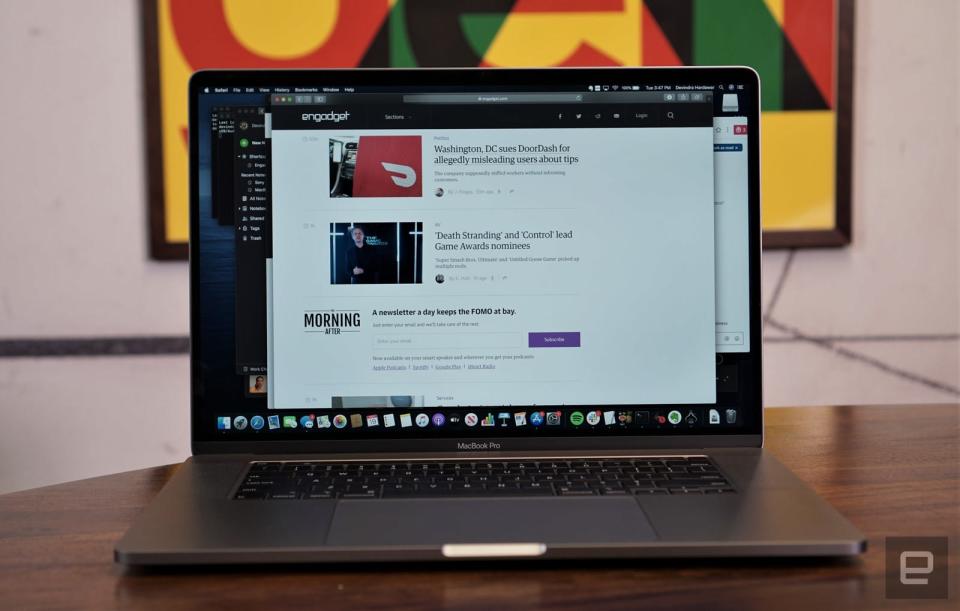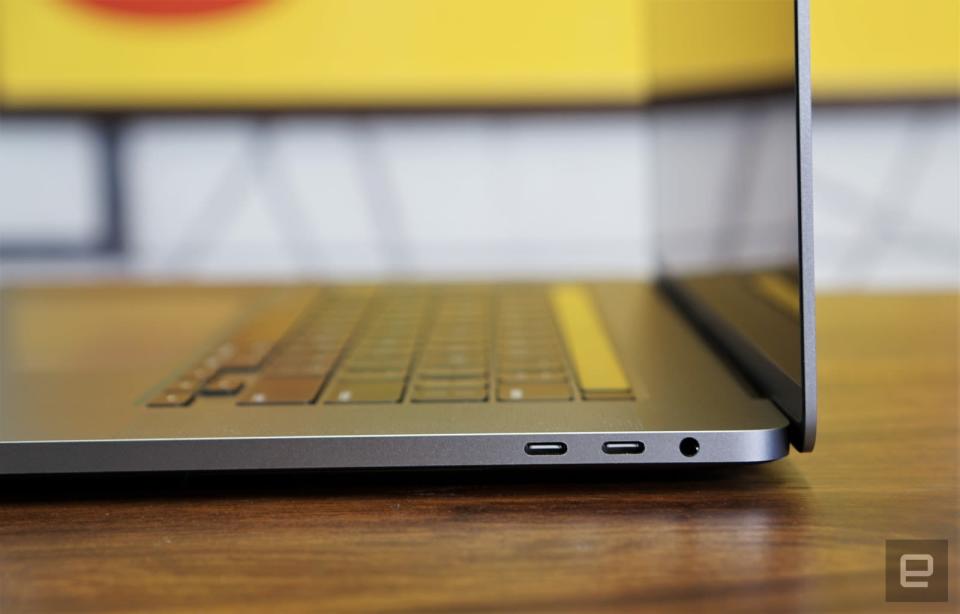MacBook Pro 16-inch review: The ultimate Apple laptop
It’s built for power, and it shows.
Talk to any true Apple fan and they'll tell you the last great MacBook Pro was the 15-inch model from mid-2015. It had a wide array of ports, a great keyboard and an SD card slot. There was no butterfly keyboard or Touch Bar to deal with. As the former Tumblr developer Marco Arment put it, "It's designed for us, rather than asking us to adapt ourselves to it."
The 16-inch MacBook Pro is the closest Apple has come to recreating the glory of that machine. It's incredibly powerful, and the company finally listened to complaints about its shallow butterfly keyboards and equipped this model with more-traditional scissor-switch keys. While it doesn't address every pro-user issue — you're still limited to four USB-C ports and there are no card slots — it's hands down the best MacBook Pro available today for creatives.

Let's get the obvious differences out of the way first: Its 16-inch screen is noticeably larger. Like many PC makers, Apple managed to fit a larger display into a similarly sized case by shaving down the bezels around the sides and top. The result is a gloriously immersive, 500-nit Retina Display that can finally compete with Dell's Infinity Edge screens. It's a legitimate step up from the previous model, and a reminder of the glory days of Apple's 17-inch notebooks.
Then there's the new Magic Keyboard — which feels more like a miracle keyboard. Mac users have been complaining about the flat Butterfly keyboards ever since they debuted. While Apple eventually fixed some sound and reliability issues, they never felt great to type on. It always felt like pretend typing on a pane of glass — it's not satisfying and barely functional. The Magic Keyboard fixes that issue by going back to the scissor mechanism Apple has been using in its desktop keyboards for years. There's a millimeter of key travel now, and they aren't wobbly like they used to be on older MacBook Pros. In comparison, the Butterfly keyboards had a mere half millimeter of travel, and Dell's XPS 15 offers a slightly deeper 1.3 millimeters.

I've almost forgotten what it was like to enjoy typing on a MacBook Pro, but this new keyboard brought me back to my early days of writing on a second-gen MacBook Air. There's a responsiveness that makes the keyboard feel inviting, like it's a world-class instrument waiting to be played. That millimeter of feedback practically makes the notebook feel like an extension of my body instead of a tool that annoys me every time I touch it. Even butterfly keyboard defenders will have a hard time denying that the Magic Keyboard simply feels better, and it can't reach other MacBooks soon enough.
Apple even compromised a bit with the Touch Bar: The physical Escape key is back! And there's a separate TouchID and power button, which makes it easier to find without looking. I'm still not completely sold on the Touch Bar's usefulness, but at least it feels like less of a hindrance to my workflow.

The 16-inch MacBook Pro is a bit taller and wider than the 15-inch model by a few millimeters, and it's marginally thicker at .64 inches instead of 0.61. It's heftier too at 4.3 pounds instead of around four. It definitely weighed down my backpack more, and its slightly larger dimensions make it a bit of a chore to fit on cramped coffee shop tables. But I think the trade-offs are worth it for the sheer power Apple managed to stuff into this machine. It would have been nice to see more of a design refresh, but Apple's unibody aluminum case looks as sleek as ever, so I can't complain much.
Under the hood, you have Intel's latest six- and eight-core i7 and i9 processors, the latter of which can reach boost speeds up to 5GHz. You can also choose between AMD's Radeon Pro 5300M and 5500M GPUs with 4GB of VRAM. That more-powerful GPU can even be configured with eight gigabytes of VRAM for heavy-duty 3D-rendering work. Apple claims the 5,300M graphics are 2.1 times faster than the 15-inch MacBook Pro's, and that makes sense since it's powered by AMD's new rDNA architecture.

Apple is breaking new ground for memory and storage in the MacBook Pro as well, with support for up to 64GB of DDR4 RAM and eight terabytes of fast SSD storage. Notably, Apple says this is the largest SSD ever in a notebook, and we haven't found any evidence out there to prove otherwise. These are fantastic high-end specs for programmers and artists alike. It used to be that you had to settle with a small SSD in a modern laptop and carry around a portable drive for larger files. The 16-inch MacBook Pro gives you the sort of storage flexibility you'd expect from a desktop workstation.
Of course, you'll pay dearly for maxing out those specs. Bumping up to 64GB of RAM is an additional $800 while the 8TB of storage is an eye-watering $2,200 extra. These aren't upgrades meant for average users, but I'd bet huge VFX firms wouldn't think twice about spending $5,899 for a decked-out MacBook Pro to speed up their workflows.

Our review unit, which featured an eight-core i9 CPU and AMD Radeon Pro 5500M graphics, tore through whatever I put in front of it. It's clearly more than I needed for my typical workflow, which mostly involves juggling a ton of browsers, light image editing, Evernote, Slack and Spotify. When I gave it a serious job, like transcoding a 4K movie clip, it leaped into action. HandBrake handled a two-minute clip in just 52 seconds, whereas it took the new 15-inch Surface Laptop 3 a full minute longer. In the Geekbench 4 Compute benchmark, the new Radeon Pro GPU also scored twice as much as the last-gen AMD hardware. Simply put, this thing screams.
As I was benchmarking the 16-inch MacBook Pro, it never felt hot to the touch, and while the fans were noticeable when they spun it, they weren't annoyingly loud. As part of the notebook's revamped cooling setup, the fans can now push out 28 percent more air than before, and the heat sink covers 35 percent more internal space. All of those improvements and the slightly larger case mean the new MacBook Pro should be able to withstand heat better than any of Apple's previous notebooks.
Apple also made a slew of other compelling upgrades to the 16-inch MacBook Pro. A new six-speaker setup makes music and movies sound great. It's no replacement for dedicated speakers, but it's impressive for something coming out of a very thin laptop. There's also a three-microphone array that Apple is putting against standalone mics like the Blue Yeti. That's definitely going a bit too far, but recordings I've made sound good... for a laptop mic at least. And there's very little background hiss. It's more useful for video chats and shouting at Siri, since pro users tend to be pretty religious about their preferred mics.

Unfortunately, you're still stuck with four Thunderbolt 3 USB-C ports for connectivity. It'd be nice to see Apple bring back an SD card reader, but unlike the keyboard, that's one area where the company is refusing to back down. At least USB-C dongles and accessories are cheaper and better these days, but I've talked to plenty of pro Apple users who still pine for the flexibility of that 2015 MacBook pro.
The new 100-watt-per-hour battery also lived up to Apple's marketing hype. The company claims it'll last up to 11 hours — during our battery test it survived for 11 hours and 20 minutes. Of course, we were just looping an HD video, so you can expect it to drain faster under heavy-duty workloads. Apple includes a new 96-watt USB-C power adapter in the box — the beefiest we've ever seen on a MacBook Pro. It's only a bit larger than the 15-inch notebook's adapter.

Surprisingly, Apple is keeping the 16-inch MacBook Pro at the same $2,399 starting price. That's a pretty great deal for all the upgrades you get. Shell out $2,799 and you can step up to the Core i9 model with the best Radeon Pro graphics. That's not too pricey for this category, though you can get that same processor and decent NVIDIA graphics on the XPS 15 for $2,350. It's no surprise that a Windows PC is cheaper — what's important is that Apple once again has a compelling high-end notebook to keep frustrated Mac users from jumping over to Windows.
The 16-inch MacBook Pro is the closest Apple has come to crafting the ultimate notebook. It's exactly the upgrade Mac fans have been waiting for, even though it might not have all the ports they want. It's so fast that I don't think the Mac faithful will mind carrying around an SD card reader.
